Tonga

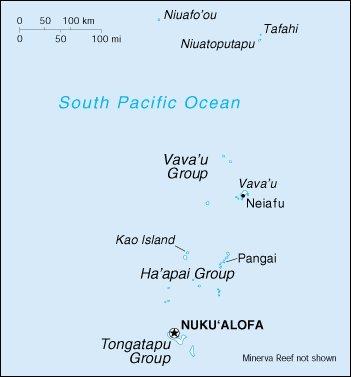
September 4,
2002
After a rather eventful three day crossing
from Niue, we arrived in fog and rain just north of Vava’u, mindful of the
proximity to the island thanks to our radar. The night before had been mostly
squally weather and winds of 20-25 knots, making for a fast passage. We were
sailing downwind on a broad reach with our jib poled out wing and wing. In
bigger seas, this causes the boat to rock from side to side. All night long we
listened to dishes rattle and bottles clank. About 3:00 am, we hit a
particularly large swell and the boom, which is quite long, dipped it’s end
into the sea causing a great strain on the preventer (a line that keeps the
boom from swinging across the deck if wind gets behind the mainsail, i.e.,
what’s called an unintentional jibe – not good!). Well, the fitting holding the
preventer to the boom sheared it’s stainless steel bolts under the pressure and
the preventer then failed. Other than the sheared fitting, there was no damage.
But, we did have to slow down and reef in the mainsail. So, it was great to see
Vava’u appear on the radar as this meant a good night’s rest was just a few
miles away.
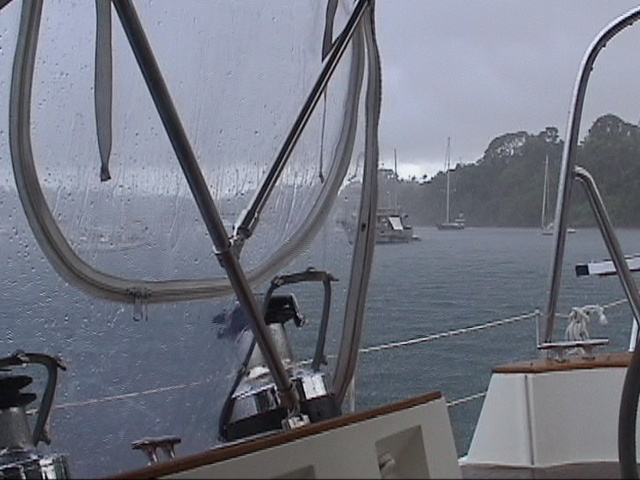
Raining at Vava'u
September 8,
2002
The rain came and went and we had some
beautiful days to enjoy, rest and relax in the harbor anchorage at Neiafu, the
main village in Vava’u. We had sailed here on a bareboat charter 13 years ago,
so, we were surprised to see all the changes. Most noticeable were the new restaurants
along the water that catered to cruisers like us.
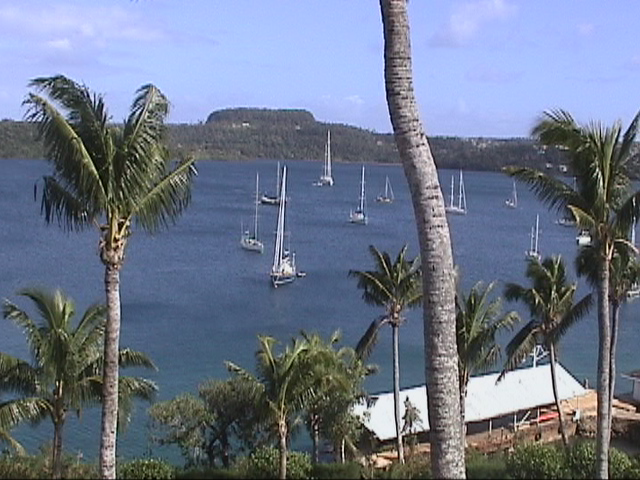
Final Straw at the Neiafu, Vava'u anchorage
September 7,
2002
The Vava’u group is a beautiful collection
of islands well protected by surrounding reefs. Like Niue, its also a breeding
ground for humpback whales. There are a couple of whale watching tours in Neiafu.
So, we decided to join them and see the humpbacks up close. We weren’t
disappointed. We sighted one almost immediately after arriving at one of the
favored spots. The sequence of video stills below shows our first sighting.
Interestingly, a bird flew across the frame helping to give perspective to the
timing of the whale’s dive.
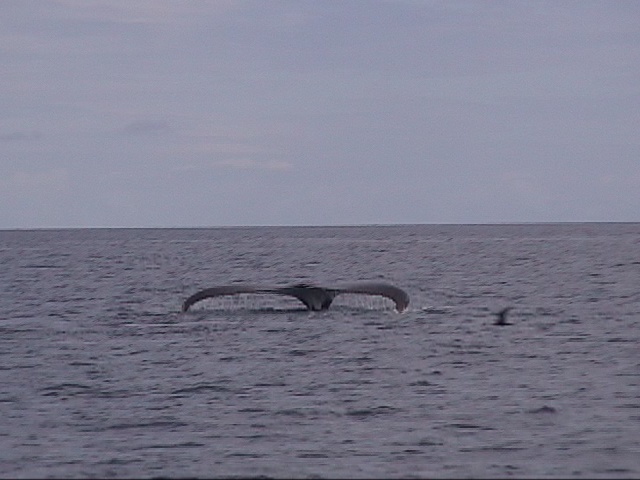
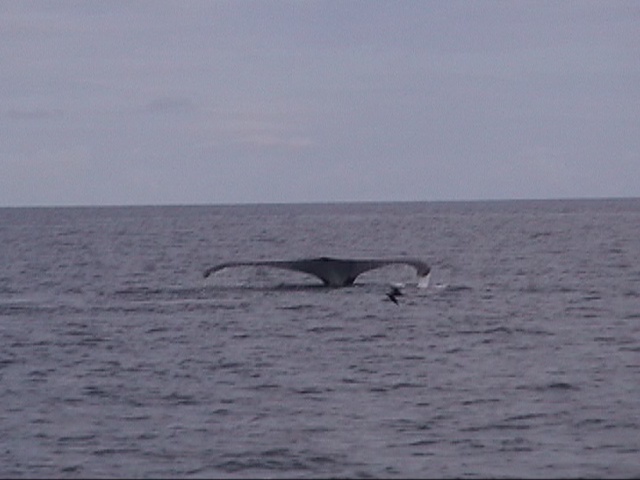

Whale sighting in Vava'u
Not long after the first sighting,
we came across a mother with her calf. This gave us an opportunity to get in
the water and slowly and carefully, so not to disturb them, swim with them. The
mother slept with one eye open while the calf rested across the mother’s nose.
What an incredible sight to be just 10-20 feet away and watch the antics of the
calf. Its truly an awesome experience!
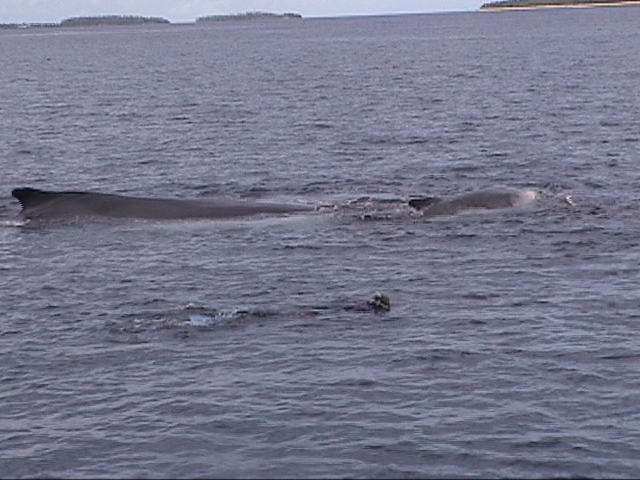
Clark swimming with a whale**
** please note, Clark is the one in the foreground!
September 11,
2002
After several days in the anchorage at
Neiafu, we took Final Straw out to explore a few of the many other islands of
the Vava’u Group. One particularly beautiful spot was Vaka’eitu island. There
is a little restaurant hidden on the hill here that opens for the cruisers visiting
the nearby beach. The photo below was taken from the hill looking towards
Hunga. It caught the sun’s rays at just the right time!
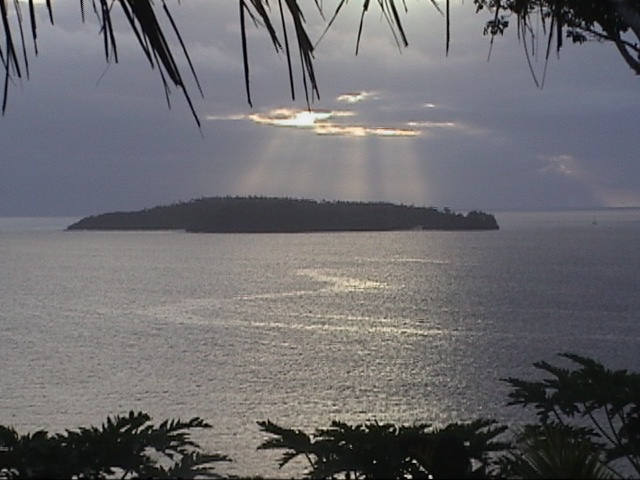
The view from Vaka'eitu
September 23,
2002
There are a few well known Tongans that make
exceptional wood carvings. We met one in Neiafu and saw one of his whale
sculptures we really liked. We bought it as a reminder of the magnificent
experience we had swimming with the humpbacks.

Tongan wood sculpture
October 15,
2002
We had a wonderful time in Vava’u after
spending 41 days here, by far the longest stay we had anywhere on the crossing.
There are memories that will last with us for a very long time. We have more
stories of yet another lively Puddle Jump party at the Paradise International
Hotel, my birthday party at the Tongan feast held at Pangaimotu, Lisa’s second
visit to Final Straw, the heist of a Mooring’s charter boat, etc. But, we’ll
save those for another time. It was now time to begin the move towards New
Zealand. Cyclone season starts in the South Pacific in just two more weeks. So,
after a nice stop at the lagoon formed by the crater of an extinct volcano at
Hunga, we departed for the Ha’apai Group. It’s a day sail, so we got up early
the next morning and headed south.

Mariner’s Cafe in Lifuka, Ha’apai
October 16,
2002
Our first stop in the Ha’apai Group was the
island of Ha’ano. This was a deserted place with a nice beach and protection from
wind and seas from all directions but west. The next day, we sailed over to
Lifuka, a few miles away. The Ha’apai Group is not visited as often as other
parts of Tonga due to the numerous coral reefs and somewhat difficult
navigation. But, it’s well worth the stop. Since it’s off the beaten path, it
has the charm of being both remote and unspoiled. At Lifuka, we met Paul Kidd,
a ham operator (A35RK) I had talked with several times. Paul met us at the
Mariner’s Café and took us around in his vehicle to see the sights.
We planned to stay in Ha’apai longer. But,
when we raised the anchor at Lifuka, the windlass started to smoke from all the
strain on the chain in 20+ knots of wind. So, we performed more surgery by
removing the motor and cleaning the armature and brushes. It worked again, but,
we were concerned about pushing our luck. So, we decided after just three days
to head for Tongatapu, an overnight sail. Here, we would meet Terry Willis who
was flying in from San Diego to join us as crew on the 1100 mile passage to New
Zealand. Suzy would catch a plane to New Zealand and meet us there. As she
says, "Nothing goes to weather like a 747!"
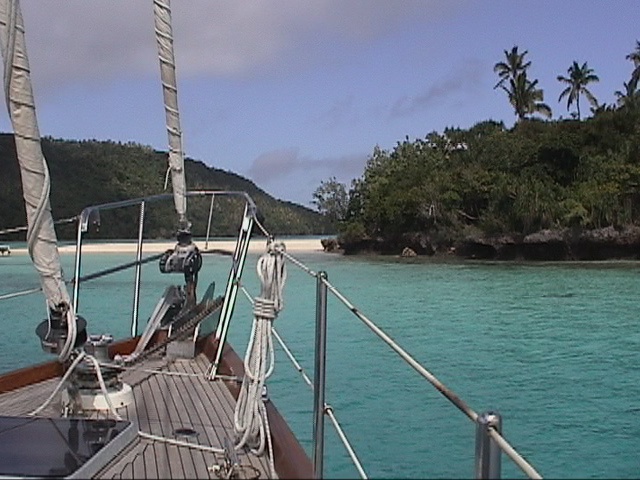
Anchored at Mala Island
October 27,
2002
By this time, Terry had
arrived and Suzy had caught her plane to New Zealand. So, we left Tonga in our
wake and headed to Minerva Reef, a two day sail on the way to New Zealand.
Minerva Reef, if the weather cooperates, is a good place to take a break and
see what is forecasted ahead. I had always wanted to stop here and put it on
the air for other ham radio operators. So, we kept our fingers crossed that the
weather would hold and off we went.
To continue the voyage to Minerva Reef and
New Zealand, click here!
To go back to the home page, click here!